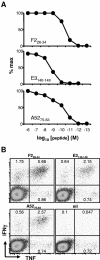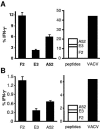Poxvirus CD8+ T-cell determinants and cross-reactivity in BALB/c mice
- PMID: 16775319
- PMCID: PMC1488955
- DOI: 10.1128/JVI.00427-06
Poxvirus CD8+ T-cell determinants and cross-reactivity in BALB/c mice
Abstract
Mouse models of orthopoxvirus disease provide great promise for probing basic questions regarding host responses to this group of pathogens, which includes the causative agents of monkeypox and smallpox. However, some essential tools for their study that are taken for granted with other mouse models are not available for these viruses. Here we map and characterize the initial CD8+ T-cell determinants for poxviruses in H-2d-haplotype mice. CD8+ T cells recognizing these three determinants make up around 40% of the total responses to vaccinia virus during and after resolution of infection. We then use these determinants to test if predicted conservation across orthopoxvirus species matches experimental observation and find an unexpectedly cross-reactive variant peptide encoded by ectromelia (mousepox) virus.
Figures



Similar articles
-
Mouse models for studying orthopoxvirus respiratory infections.Methods Mol Biol. 2004;269:289-308. doi: 10.1385/1-59259-789-0:289. Methods Mol Biol. 2004. PMID: 15114022 Review.
-
Insufficient Innate Immunity Contributes to the Susceptibility of the Castaneous Mouse to Orthopoxvirus Infection.J Virol. 2017 Sep 12;91(19):e01042-17. doi: 10.1128/JVI.01042-17. Print 2017 Oct 1. J Virol. 2017. PMID: 28747505 Free PMC article.
-
Protection against lethal vaccinia virus challenge in HLA-A2 transgenic mice by immunization with a single CD8+ T-cell peptide epitope of vaccinia and variola viruses.J Virol. 2004 Jul;78(13):7052-60. doi: 10.1128/JVI.78.13.7052-7060.2004. J Virol. 2004. PMID: 15194781 Free PMC article.
-
Dissociation between epitope hierarchy and immunoprevalence in CD8 responses to vaccinia virus western reserve.J Immunol. 2008 Jun 1;180(11):7193-202. doi: 10.4049/jimmunol.180.11.7193. J Immunol. 2008. PMID: 18490718 Free PMC article.
-
Controlling orthopoxvirus infections--200 years after Jenner's revolutionary immunization.Arch Immunol Ther Exp (Warsz). 1996;44(5-6):373-8. Arch Immunol Ther Exp (Warsz). 1996. PMID: 9017154 Review.
Cited by
-
Deficiency in Th2 cytokine responses exacerbate orthopoxvirus infection.PLoS One. 2015 Mar 9;10(3):e0118685. doi: 10.1371/journal.pone.0118685. eCollection 2015. PLoS One. 2015. PMID: 25751266 Free PMC article.
-
CD4 T-cell-mediated heterologous immunity between mycobacteria and poxviruses.J Virol. 2009 Apr;83(8):3528-39. doi: 10.1128/JVI.02393-08. Epub 2009 Feb 4. J Virol. 2009. PMID: 19193795 Free PMC article.
-
Strikingly poor CD8+ T-cell immunogenicity of vaccinia virus strain MVA in BALB/c mice.Immunol Cell Biol. 2014 May-Jun;92(5):466-9. doi: 10.1038/icb.2014.10. Epub 2014 Feb 25. Immunol Cell Biol. 2014. PMID: 24566805 Free PMC article.
-
Poxvirus-based active immunotherapy synergizes with CTLA-4 blockade to increase survival in a murine tumor model by improving the magnitude and quality of cytotoxic T cells.Cancer Immunol Immunother. 2016 May;65(5):537-49. doi: 10.1007/s00262-016-1816-7. Epub 2016 Mar 10. Cancer Immunol Immunother. 2016. PMID: 26961085 Free PMC article.
-
Orthopoxvirus Zoonoses-Do We Still Remember and Are Ready to Fight?Pathogens. 2023 Feb 21;12(3):363. doi: 10.3390/pathogens12030363. Pathogens. 2023. PMID: 36986285 Free PMC article. Review.
References
-
- Belyakov, I. M., P. Earl, A. Dzutsev, V. A. Kuznetsov, M. Lemon, L. S. Wyatt, J. T. Snyder, J. D. Ahlers, G. Franchini, B. Moss, and J. A. Berzofsky. 2003. Shared modes of protection against poxvirus infection by attenuated and conventional smallpox vaccine viruses. Proc. Natl. Acad. Sci. USA 100:9458-9463. - PMC - PubMed
-
- Bronte, V., M. W. Carroll, T. J. Goletz, M. Wang, W. W. Overwijk, F. Marincola, S. A. Rosenberg, B. Moss, and N. P. Restifo. 1997. Antigen expression by dendritic cells correlates with the therapeutic effectiveness of a model recombinant poxvirus tumor vaccine. Proc. Natl. Acad. Sci. USA 94:3183-3188. - PMC - PubMed
Publication types
MeSH terms
Substances
Grants and funding
LinkOut - more resources
Full Text Sources
Other Literature Sources
Molecular Biology Databases
Research Materials

